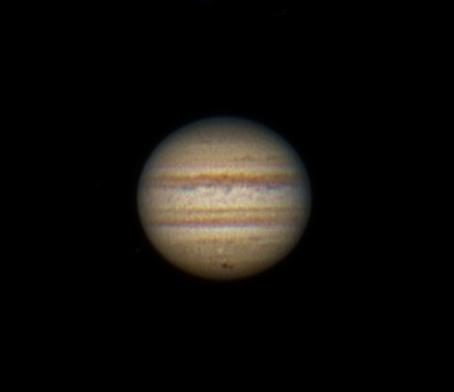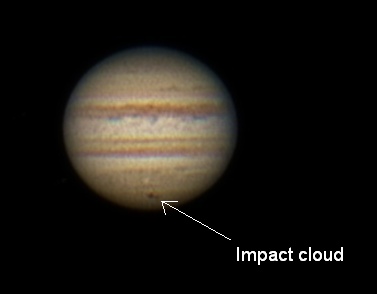
On July 19, 2009, an amateur astronomer discovered that Jupiter was hit by a comet or asteroid. The best estimates indicate that the object that hit Jupiter was about 100 meters in diameter. The impact left a black cloud near Jupiter's south pole. Afterwards, the cloud expanded in size and spread out as a result of turbulence and jet streams in Jupiter's atmosphere. This image was taken on July 28, which was nine days after the impact. The dark impact cloud is reminiscent of the impact spots left by the fragments of Comet Shoemaker-Levy 9 when it hit Jupiter in July 1994. This discovery also shows the value of dedicated amateur astronomers and the contributions they can make in astronomy.
Many scientists believe that Jupiter protects the planet Earth from being hit more often by comets and asteroids, because its massive size and strong gravity capture many such objects that might otherwise enter the inner solar system where we are located. All you have to do is go out at night and gaze up at the Moon, and you will see a record of the impacts that have taken place in this part of the solar system. This impact on Jupiter reminds us that comets and asteroids are still impacting planets even today. As David Levy has said, the question is not whether the Earth is going to be hit again by a large comet or asteroid - - instead the question is when.
At the time this image was taken, Jupiter was only 1-1/2 degrees away from Neptune.
This image was taken with a ToUcam webcam using a Takahashi FCT-150 refractor on a Takahashi NJP mount. The image was taken from my backyard in Scottsdale, Arizona.
Constellation: Capricornus
RA: 21h 47m 41s Dec: -14d 24' 46"
July 28, 2009 at 0830 U.T.
Image by Sid Leach
Scottsdale, Arizona

Recent Images.
Complete list of images.
Description of equipment used to acquire images.
Home
Feedback and comments should go to Sid